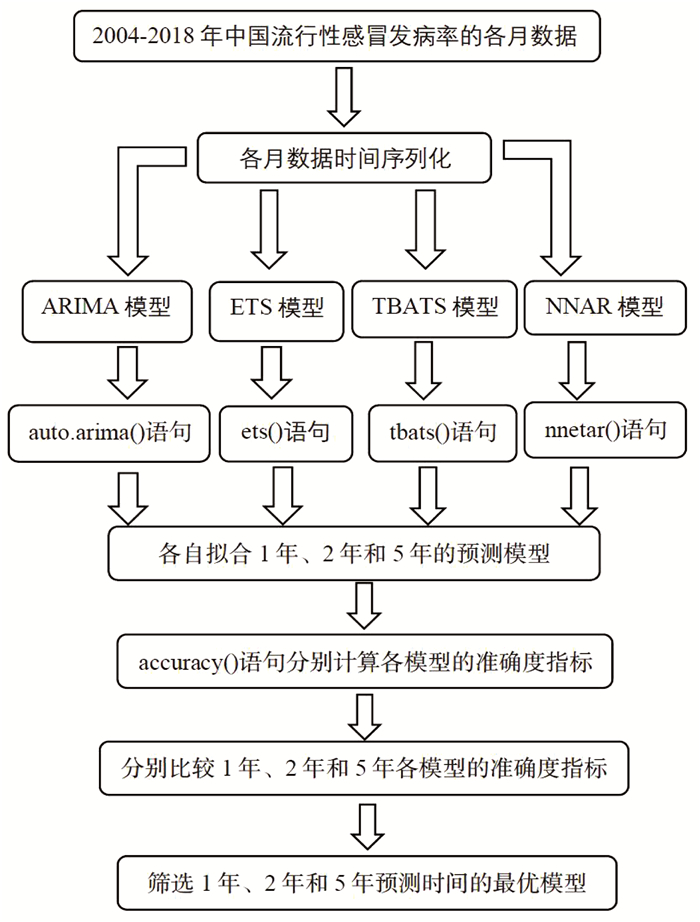Spatial-temporal analysis and prediction model for the incidence of influenza from 2004 to 2018 in China
-
摘要:
目的 分析2004―2018年中国流行性感冒(简称流感)发病的时空特征和预测发病率,为流感防控提供数据参考。 方法 获取2004―2018年全国流感发病率资料,采用Arcgis 10.8、Geoda和SaTScan 10.01软件分别进行流感发病率可视化分级地图绘制、空间自相关以及时空扫描分析,同时使用自回归移动平均(autoregressive integrated moving average model, ARIMA)模型、指数平滑(exponentialsmoothing, ETS)模型、指数平滑空间状态(trigonometric seasonality, Box-Cox transformation, TBATS)模型和神经网络自回归(neural network autoregression, NNAR)模型分别预测1年、2年、5年的发病率并比较准确度。 结果 2004―2018年全国流感的发病率逐年升高,北京市、华东和华南地区发病率明显高于全国平均水平。全国流感基本不存在全局相关但存在局部聚集。北京市和天津市长期呈现高-高或低-高聚集,2014―2016年福建省和江西省呈现高-高聚集。2014―2018年的时空扫描分析与空间相关分析结果基本一致,一类聚集区以江西省为中心、二类聚集区以北京市为中心。1年、2年和5年的最佳预测模型分别为NNAR、ETS和ARIMA模型。 结论 2004―2018年全国流感发病率逐年升高,北京市、华东和华南大部分地区成为流感的高发地区,各地可根据本地区流感的时空特征制定相应防控措施。 Abstract:Objective To analyze the spatial and temporal characteristics of influenza and predict incidence from 2004 to 2018 in China, and to provide data refence for influenza prevention and control. Methods Data about the incidence of influenza in China from 2004 to 2018 was collected. Arcgis, Geoda and SaTScan software were used to visualize and classify the incidence of influenza by mapping, spatial autocorrelation and spatial-temporal scanning analysis respectively. The autoregressive integrated moving average model (ARIMA), exponentialsmoothing (ETS), trigonometric seasonality, Box-Cox transformation (TBATS) and neural network autoregression (NNAR) models were used to predict the 1-, 2- and 5- year incidence and compare the accuracy respectively. Results The incidence of influenza increased year by year from 2004 to 2018, and the incidence in Beijing, East China and South China were significantly higher than the national average. There was basically no global correlation but local aggregation of influenza in China. The Beijing and Tianjin City showed a high-high or low-high aggregation for a long time, and Fujian and Jiangxi Province showed a high-high aggregation from 2014 to 2016. From 2014 to 2018 and spatial correlation analysis were basically consistent, I and II aggregation areas with Fujian and Beijing as aggregation centers respectively. The best forecasting models for 1-, 2- and 5 years were NNAR, ETS and ARIMA models, respectively. Conclusions The incidence of influenza increased year by year from 2004 to 2018, and Beijing, East and South China became high incidence areas for influenza. Each area can develop appropriate preventive and control measures according to the spatial and temporal characteristics of influenza. -
Key words:
- Influenza /
- Classification map /
- Spatial autocorrelation /
- Spatial-temporal scanning /
- Prediction model
-
表 1 2004―2018年全国流行性感冒发病率的全局自相关分析结果
Table 1. Global spatial autocorrelation of influenza incidence from 2004 to 2018 in China
年份(年) Moran's I值 Z值 P值 2004 0.173 1.779 0.043 2005 0.195 2.310 0.024 2006 -0.080 -0.428 0.350 2007 -0.071 -0.374 0.376 2008 -0.046 -0.163 0.463 2009 0.206 2.024 0.027 2010 -0.058 -0.286 0.435 2011 -0.079 -0.538 0.325 2012 0.034 0.478 0.286 2013 0.021 0.408 0.324 2014 -0.001 0.247 0.405 2015 -0.092 -0.535 0.318 2016 -0.058 -0.267 0.430 2017 0.052 0.774 0.195 2018 -0.054 -0.293 0.440 表 2 2004―2018年全国流行性感冒发病率的空间时间扫描分析结果
Table 2. Spatial-temporal scanning analysis of incidence of China incidence from 2004 to 2018
扫描时间(年) 高发时间(年) 类别 (坐标)/半径 人口数(人) 聚集地区 实际例数(例) RR值 LLR值 P值 2004―2008 2004―2005 1 (24.141072 N, 101.301313 E)/896.95 km 240 732 048 云南、贵州、四川、广西、重庆 51 427 3.50 24 464.57 < 0.001 2004―2005 2 (41.473741 N, 123.516401 E)/1 219.42 km 600 594 010 辽宁、吉林、天津、北京、黑龙江、山东、河北、内蒙古、山西、江苏、上海、安徽、河南 13 011 0.26 16 599.39 < 0.001 2006―2007 3 (37.366408 N, 105.985434 E)/250.73 km 31 986 084 宁夏、甘肃 8 763 3.93 5 366.73 < 0.001 2006 4 (26.003525 N, 118.024644 E)/560.26 km 217 822 393 福建、江西、浙江、广东 15 021 1.97 2 674.18 < 0.001 2009―2013 2009 1 (24.141072 N, 101.301313 E)/1 535.63 km 594 816 025 云南、贵州、四川、广西、重庆、海南、湖南、广东、陕西、甘肃、青海、湖北、西藏、江西、宁夏 130 726 2.99 48 805.11 < 0.001 2012―2013 2 (37.698500 N, 112.382576 E)/270.94 km 106 704 791 山西、河北 53 979 3.03 22 486.52 < 0.001 2010―2011 3 (41.473741 N, 123.516401 E)/734.69 km 236 817153 辽宁、吉林、天津、北京、黑龙江、山东 10 816 0.25 16 738.38 < 0.001 2014―2018 2017―2018 1 (27.734628 N, 115.633583 E)/545.34 km 436 151 850 江西、福建、湖南、湖北、浙江、安徽、广东 705 316 3.87 344 784.53 < 0.001 2017―2018 2 (40.222103 N, 116.443545 E)/0 km 21 561 487 北京 120 326 10.38 169 656.10 < 0.001 表 3 全国流行性感冒发病率不同模型预测效果的准确度
Table 3. Accuracy of different prediction models for influenza incidence of China
模型 数据集 1年 2年 5年 RMSE MAE MASE MAPE RMSE MAE MASE MAPE RMSE MAE MASE MAPE ARIMA 训练集 0.721 0.329 0.577 36.955 0.557 0.290 0.624 37.822 0.330 0.167 0.439 32.712 测试集 4.892 4.892 8.575 293.05 6.360 5.178 11.144 299.809 3.209 1.333 3.496 35.387 ETS 训练集 0.721 0.338 0.593 36.899 0.437 0.248 0.534 36.451 0.375 0.181 0.475 34.757 测试集 6.709 6.013 10.539 380.027 4.080 2.336 5.026 64.495 2.751 1.488 3.902 73.263 TBTAS 训练集 0.674 0.295 0.518 30.700 0.419 0.233 0.501 30.210 0.369 0.180 0.472 33.628 测试集 4.487 3.859 6.764 179.429 4.122 2.434 5.239 76.109 3.185 2.421 6.350 164.062 NNAR 训练集 0.320 0.215 0.377 35.843 0.115 0.079 0.170 30.210 0.254 0.155 0.406 34.321 测试集 5.468 3.671 6.435 96.974 4.819 2.759 5.938 76.109 3.111 1.476 3.870 58.342 -
[1] 杜志成, 张王剑, 郝元涛. 中国主要呼吸道传染病分布模式及其社会经济影响因素[J]. 中华疾病控制杂志, 2016, 20(1): 5-8. DOI: 10.16462/j.cnki.zhjbkz.2016.01.002.Du ZC, Zhang WJ, Hao YT, Distribution patterns of the main respiratory infectious diseases in China and their associated socio-economic factors[J]. Chin J Dis Control Prev, 2016, 20(1): 5-8. DOI: 10.16462/j.cnki.zhjbkz.2016.01.002. [2] 赵金华, 马永成, 石燕, 等. 2009―2018年青海省流行性感冒病毒变迁规律[J]. 中华疾病控制杂志, 2020, 24(6): 696-700. DOI: 10.16462/j.cnki.zhjbkz.2020.06.015.Zhao JH, Ma YC, Shi Y, et al. The changes of influenza virus in Qinghai Province from 2009 to 2018[J]. Chin J Dis Control Prev, 2020, 24(6): 696-700. DOI: 10.16462/j.cnki.zhjbkz.2020.06.015. [3] 吴迪, 刘艳慧, 曹蓝, 等. 广州市2017―2020年流感流行特征分析[J]. 中国预防医学杂志, 2022, 23(1): 37-43. DOI: 10.16506/j.1009-6639.2022.01.007.Wu D, Liu YH, Cao L, et al. Epidemiological characteristics of influenza in Guangzhou from 2017 to 2020[J]. Chinese Preventive Medicine, 2022, 23(1): 37-43. DOI: 10.16506/j.1009-6639.2022.01.007. [4] 傅伟杰, 丁晟, 程慧健, 等. 2017―2019年江西省流行性感冒时空聚集性分析[J]. 中华疾病控制杂志, 2022, 26(1): 80-85. DOI: 10.16462/j.cnki.zhjbkz.2022.01.014.Fu WJ, Ding S, Cheng HJ, et al. Spatiotemporal clustering analysis of influenza in Jiangxi Province from 2017 to 2019[J]. Chin J Dis Control Prev, 2022, 26(1): 80-85. DOI: 10.16462/j.cnki.zhjbkz.2022.01.014. [5] 史进梅, 赵俊琴, 李建国. 空间自相关方法及其在公共卫生领域的应用[J]. 中华劳动卫生职业病杂志, 2020, 38(5): 395-400. DOI: 10.3760/cma.j.cn121094-20190507-00183.Shi JM, Zhao JQ, Li JG. Spatial autocorrelation and its application in public health field[J]. Chin J Ind Hyg Occup Dis, 2020, 38(5): 395-400. DOI: 10.3760/cma.j.cn121094-20190507-00183. [6] 秦颖, 赵梦娇, 谭亚运, 等. 中国流感大流行的百年历史[J]. 中华流行病学杂志, 2018, 39(8): 1028-1031. DOI: 10.3760/cma.j.issn.0254-6450.2018.08.003.Qin Y, Zhao MJ, Tan YY, et al. History of influenza pandemics in China during the past century[J]. Chin J Epidemiol, 2018, 39(8): 1028-1031. DOI: 10.3760/cma.j.issn.0254-6450.2018.08.003. [7] 杨静, 陈涛, 祝菲, 等. 2017~2018年度中国大陆流行性感冒病例报告情况分析[J]. 热带病与寄生虫学, 2018, 16(2): 63-66. DOI: 10.3969/j.issn.1672-2302.2018.02.001.Yang J, Chen T, Zhu F et al. Analysis of the reported influenza cases in mainland China between 2017 and 2018[J]. J Trop Dis Parasitol, 2018, 16(2): 63-66. DOI: 10.3969/j.issn.1672-2302.2018.02.001. [8] 栾桂杰, 周脉耕. 中国2004-2016年冬季低温与流感发病的相关性研究[J]. 中华流行病学杂志, 2020, 41(3): 368-372. DOI: 10.3760/cma.j.issn.0254-6450.2020.03.017.Luan GJ, Zhou MG. Correlation between low air temperature and influenza incidence in winter in China, 2004-2016[J]. Chin J Epidemiol, 2020, 41(3): 368-372. DOI: 10.3760/cma.j.issn.0254-6450.2020.03.017. [9] 查文婷, 李渭通, 何嘉慧, 等. 湖南省流行性感冒与气象因素关系及预测[J]. 中国公共卫生, 2021, 37(3): 537-541. DOI: 10.11847/zgggws1127362.Zha WT, Li WT, He JH, et al. Association of meteorological factors with influenza incidence in Hunan province: a time series model based analysis and prediction[J]. Chin J Public Health, 2021, 37(3): 537-541. DOI: 10.11847/zgggws1127362. [10] 陈昌明, 刘艳慧, 陆剑云, 等. 广州市白云区2015―2020年流行性感冒流行特征分析[J]. 医学动物防制, 2021, 37(7): 613-616, 620. DOI: 10.7629/yxdwfz202107001.Chen CM, Liu YH, Lu JY, et al. Analysis on epidemiological characteristics of influenza in Baiyun District Guangzhou during 2015 to 2020[J]. J Med Pest Control, 2021, 37(7): 613-616, 620. DOI: 10.7629/yxdwfz202107001. [11] 朱旗莉, 旷翠萍, 马茂. 2009―2018年深圳市罗湖区传染病聚集性疫情分析[J]. 职业与健康, 2020, 36(10): 1328-1331. DOI: 10.13329/j.cnki.zyyjk.2020.0354.Zhu QL, Kuang CP, Ma M. Analysis on epidemic clusters of infectious diseases in Luohu District of Shenzhen City from 2009-2018[J]. Occupation and Health, 2020, 36(10): 1328-1331. DOI: 10.13329/j.cnki.zyyjk.2020.0354. [12] 周扬, 梁士杰. ARIMA乘积季节模型在郑州市肺结核月发病趋势预测中的应用[J]. 中国卫生统计, 2021, 38(4): 554-555. DOI: 10.3969/j.issn.1002-3674.2021.04.019.Zhou Y, Liang SJ. Application of ARIMA product seasonal model in predicting the monthly incidence trend of pulmonary tuberculosis in Zhengzhou city[J]. Chinese Journal of Health Statistics, 2021, 38(4): 554-555. DOI: 10.3969/j.issn.1002-3674.2021.04.019. [13] 朱佳佳, 胡登利, 洪秀琴, 等. 基于时空大数据的甲型肝炎发病率分布特征分析及预测模型[J]. 中华疾病控制杂志, 2018, 22(11): 1144-1147. DOI: 10.16462/j.cnki.zhjbkz.2018.11.012.Zhu JJ, Hu DL, Hong XQ, et al. Analysis of distribution characteristics and prediction model of hepatitis A incidence based on spatiotemporal big data[J]. Chin J Dis Control Prev, 2018, 22(11): 1144-1147. DOI: 10.16462/j.cnki.zhjbkz.2018.11.012. [14] 沙小兰, 李燕, 刘小娟, 等. 2009―2018年银川市流行性感冒流行特征及发病趋势预测[J]. 中华疾病控制杂志, 2020, 24(8): 881-885, 928. DOI: 10.16462/j.cnki.zhjbkz.2020.08.004.Sha XL, Li Y, Liu XJ, et al. Analysis of epidemiological characteristics and trend prediction of influenza in Yinchuan City from 2009 to 2018[J]. Chin J Dis Control Prev, 2020, 24(8): 881-885, 928. DOI: 10.16462/j.cnki.zhjbkz.2020.08.004 [15] 马倩倩, 何贤英, 崔芳芳, 等. 基于ARIMA与NNAR模型的中国食管癌疾病负担预测[J]. 中华疾病控制杂志, 2021, 25(9): 1048-1053. DOI: 10.16462/j.cnki.zhjbkz.2021.09.010.Ma QQ, He XY, Cui FF, et al. Prediction of disease burden of esophageal cancer in China based on ARIMA and NNAR models[J]. Chin J Dis Control Prev, 2021, 25(9): 1048-1053. DOI: 10.16462/j.cnki.zhjbkz.2021.09.010. [16] 祁娟, 陈守义, 陈海燕, 等. 基于三种时间序列模型对广州市肾综合征出血热发病率的预测比较研究[J]. 医学动物防制, 2021, 37(5): 485-489. DOI: 10.7629/yxdwfz202105021.Qi J, Chen SYi, Chen HY, et al. A comparative prediction study on the incidence of hemorrhagic fever with renal syndrome in Guangzhou based on three time series models[J]. J Med Pest Control, 2021, 37(5): 485-489. DOI: 10.7629/yxdwfz202105021. [17] Perone G. Comparison of ARIMA, ETS, NNAR, TBATS and hybrid models to forecast the second wave of COVID-19 hospitalizations in Italy[J]. Eur J Health Econ, 2021, 37(5): 485-489. DOI: 10.1007/s10198-021-01347-4. -





 下载:
下载:





